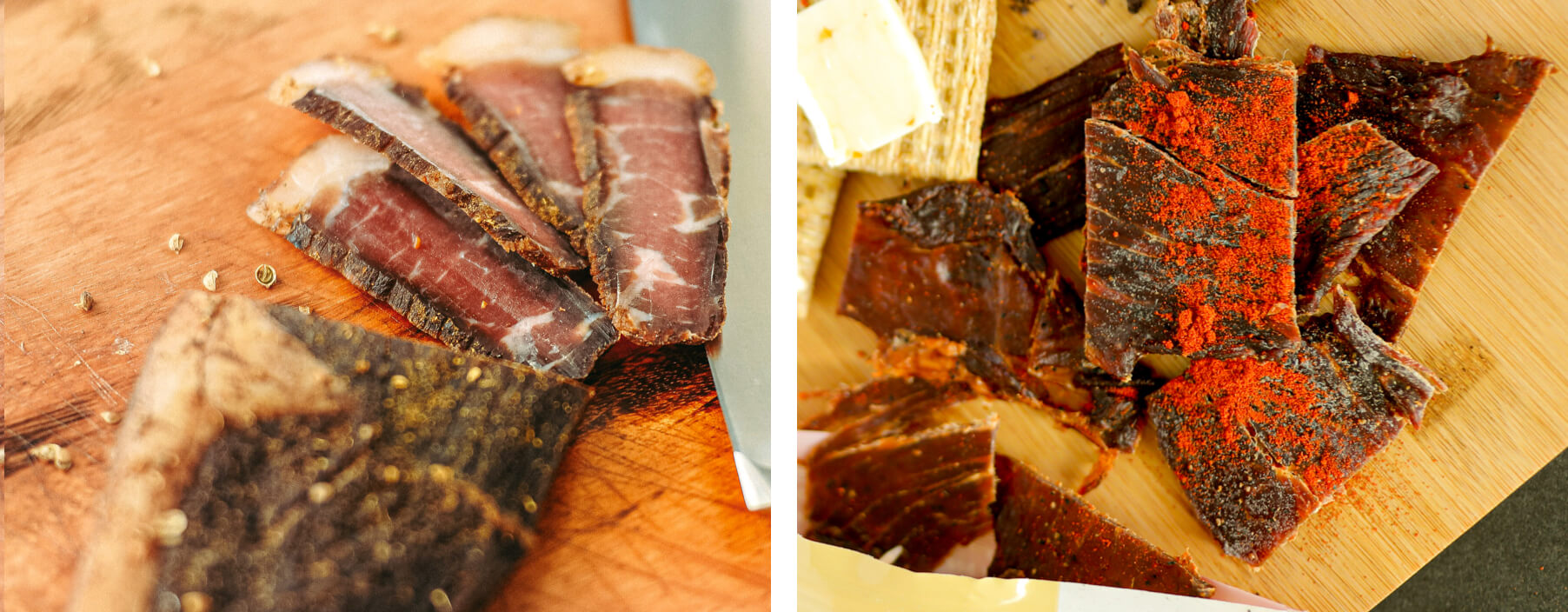
What Is the Difference Between Biltong and Jerky?
It's easy to get biltong and jerky mixed up. They have similar appearances, are made from strips of meat, and are both considered healthy snacks. But the similarities end there.
Jerky and biltong have quite a few differences on the inside, such as how they're made, the way they taste and more.
So, if you're wondering how biltong and jerky are different, read on to find out.
Jerky vs Biltong: Main Differences
Jerky and biltong both belong to the same family of dried meat snacks but think of them more as long-lost cousins rather than twin siblings.
Each type of dried meat is unique; the main differences are listed below.
Ingredients
Jerky and biltong are both made from meat and seasoned with spices, but each use their own distinctive ingredients. Beef is the most common meat ingredient, but others are also used. Other differences include:
| Ingredients | |||
|---|---|---|---|
| Dried Meat Type | Cut of Meat | Marinade Contents | Spices |
| Jerky | Thin, Lean Strips | Varied: Agave, Honey, Liquid Smoke, Soy/Tamari/Teriyaki Sauce, Vinegar, Worcestershire Sauce, etc. | Varied: Black Pepper, Garlic, Onion Powder, Red Pepper, Salt, etc. |
| Biltong | Thicker, Fattier Strips | Vinegar | Varied: Allspice, Brown Sugar, Clove, Coriender, Curry, Salt, etc. |
Beyond being referred to as spiced meat, the ingredients used in jerky and biltong don't have much else in common.
Process
The process of preserving each type of meat snack also contributes to differences like taste and texture.
| Method of Preservation | ||
|---|---|---|
| Dried Meat Type | Marinade Type | Finishing |
| Jerky | Salt-Based | Dried using heat and smoke | Biltong | Vinegar-Based | Cured without the use of heat |
Jerky
Jerky slices are soaked in a marinade to preserve the meat, placed in an oven or on a rack and are then dehydrated with the use of heat and smoke.
Biltong
Biltong strips are bathed in a vinegar marinade to preserve the meat and are then dried in room temperature air.
The different processing methods result in a variation of texture.
Texture
Jerky and biltong also feature significant differences in mouthfeel. Generally, biltong has a greater variety of textures than jerky.
Biltong can be served before the meat is fully cured and dried, so it can be more supple.
Jerky is always fully dried which means it is usually tougher than biltong. In addition, use of leaner meats can make jerky tougher.
Origins
Jerky and biltong originate from different geographic regions.
Jerky comes from South America and biltong is from Southern Africa.
| Jerky | Biltong |
 |
 |
Believed to have originated in the ancient Inca Empire in the 16th century | Traced to many different cultures living in Southern Africa in the 16th century |
Taste
Perhaps the biggest difference between jerky and biltong is taste. For those that have tried both, the flavor profiles are very distinctive:
Jerky's most distinguishing characteristic is it's smokey and savory flavor.
The unique flavor of biltong is best described as acidic or vinegary, which stems from its marinade.
Does one taste better than the other? Like most things, it's up to personal preference.
Jerky and Biltong: Similar, But Different
Jerky and biltong may seem identical at first glance, but they're different types of dried meat snacks from opposite sides of the planet. Biltong is more acidic, fattier and has a softer texture versus jerky which is smokier, leaner, and chewier.
At Karl Family Farms, we're known for our traditionally made jerky. From our Bee-Sting Beef Jerky to our fruitwood-smoked Pork Jerky, we're sure that if you try it, you'll like it.